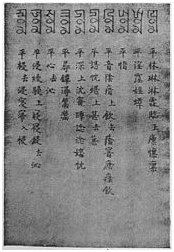Part A Reading: From impossibly hard to naturally easy


Do you find the Part A OET reading task too hard? You probably don’t have a good system for approaching the test.
This task can seem impossible. You have 15 minutes to read four texts and then answer more than 20 questions. And you have to get the grammar correct too!
I once had a student who had below than average spoken English, and she had a lot of trouble with the writing task too. However, unlike the rest of the class, she found Part A to be naturally easy. Even though English was her second language, she could finish any Part A task I threw at her with minutes to spare. Why was she so good at it?
This was because she had a systematic approach to handling the test – and to do well in the test, you will need to internalize this approach so that it becomes automatic. How do you do this?
Step 1:
Do not read the entire texts! You need to rapidlyscan and skim for certain details that will help you characterize each of the four texts so that you know where to find you answer.
These details include things like:
- Headings
- Author
- Year
- Location
Now you need to quickly give a unique personality to each of the texts so that you can remember which one is which. For example: “Text 1: Spanish study from 1999; Text 2: Statistics from 2005; Text 3: Study by O’Neill et al.; Text 4: Australian Guidelines for approaching asthma”.
Step 2:
Now keywords in the gap-fill will tell you immediately which text you need to find your answer from. The first sentence might read: “Asthma is a common condition. In Spain, _____________ of people suffer from asthma.”Which text are you going to get your answer from?
For more tips on how to develop your systematic approach, feel free to contact any of the teachers at SLS – and don’t forget, practice makes perfect!
Jaime
Old Mandarin

After the fall of the Northern Song dynasty, northern China was under the control of the Jin (Jurchen) and Yuan (Mongol) dynasties. During this period, a new common speech developed, based on the dialects of the North China Plain around the capital, a language referred to as Old Mandarin. New genres of vernacular literature were based on this language, including verse, drama and story forms.
The rhyming conventions of the new verse were codified in a rhyme dictionary called the Zhongyuan Yinyun (1324). A radical departure from the rhyme table tradition that had evolved over the previous centuries, this dictionary contains a wealth of information on the phonology of Old Mandarin. Further sources are the ‘Phags-pa script based on the Tibetan alphabet, which was used to write several of the languages of the Mongol empire, including Chinese, and the Menggu Ziyun, a rhyme dictionary based on ‘Phags-pa. The rhyme books differ in some details, but overall show many of the features characteristic of modern Mandarin dialects, such as the reduction and disappearance of final stop consonants and the reorganization of the Middle Chinese tones.
Classifiers in Vietnamese Language
Classifiers are considered to be one of the most complicated parts of speech in learning Vietnamese language. In a sentence, classifier functions as a noun when it is followed by another noun.
In English we say one pen, two pens, three pens, etc. However, bút in Vietnamese must be accompanied by the classifier cây. Therefore, a pencil in English is một cây bút in Vietnamese. Never do people say một bút, hai bút, but một cây bút, hai cây bút … Similarly, listed below are 3 useful classifiers which are commonly used.
Cái ‘item’ has become one of the most common classifiers for daily life things such as: cái bàn ‘table’, cái chén ‘small bowl’, cái giuờng ‘bed’, cái cửa sổ ‘window’, cái gương ‘mirror’.
Con ‘child’ is a classifier which indicated a single creature such as con chó ‘dog’, con bướm ‘butterfly’, con dao ‘knife’, con sông ‘river’
Bó ‘bunch’, several common terms are bó hoa ‘bunch of flowers’, bó rau muống ‘bunch of morning glory’ and bó lúa ‘bundle of rice’.
Want to Learn Vietnamese? Then You MUST Read This…
Learning a new language can be fun and time-consuming and Vietnamese is no exception. As a Vietnamese teacher, I can understand the difficulty students have to overcome and I am happy to give you some tips to master this very interesting language.
1. Create a schedule to practice Vietnamese for at least 30 minutes per day. As a saying goes, ‘Practice makes perfect’, practice diligently daily will help you become a fluent Vietnamese speaker.
2. Get involved with the Vietnamese community surrounding your living area such as Vietnamese restaurant, grocery store and cultural festival. This will be extremely useful in learning Vietnamese culture and finding people to speak Vietnamese to.
3. Listening to Vietnamese songs and watching movies are good ways to familiarize yourself with pronunciation. Thinking how surprise your friends will be if you can sing a Vietnamese song on some special occasion!
4. Travel to Vietnam. This might be the hardest way but spending time in Vietnam is considered to be the quickest way to learn the language. When you are put in a situation where you have to speak the language to communicate, you can fasten your learning speed tremendously.
– Jenny Lee (Vietnamese Language Consultant)



Latest Comments